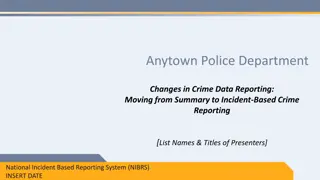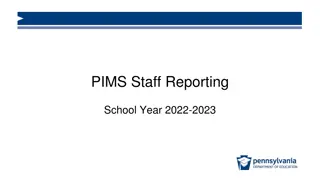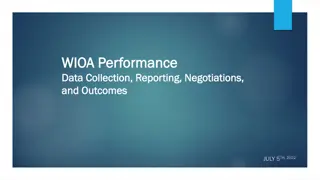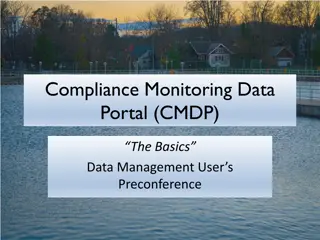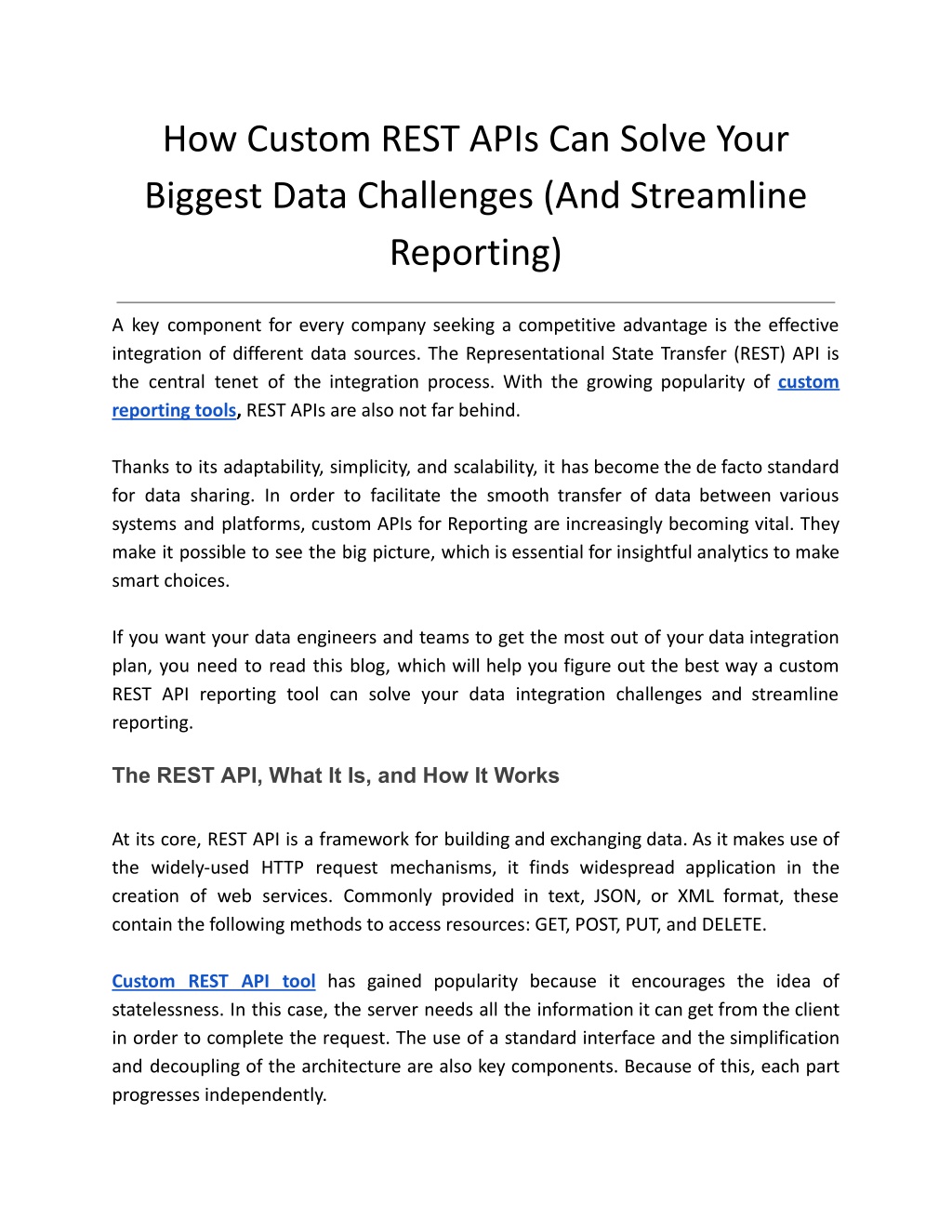
How Custom REST APIs Can Solve Your Biggest Data Challenges (And Streamline Reporting)
With dynamic BI reports and dashboards, Grow is a state-of-the-art BI reporting solution that offers insights that can be used. Grow ensures your BI reporting is accurate and up to date by integrating seamlessly with over 100 data connectors, includi
Download Presentation

Please find below an Image/Link to download the presentation.
The content on the website is provided AS IS for your information and personal use only. It may not be sold, licensed, or shared on other websites without obtaining consent from the author. Download presentation by click this link. If you encounter any issues during the download, it is possible that the publisher has removed the file from their server.
E N D
Presentation Transcript
How Custom REST APIs Can Solve Your Biggest Data Challenges (And Streamline Reporting) A key component for every company seeking a competitive advantage is the effective integration of different data sources. The Representational State Transfer (REST) API is the central tenet of the integration process. With the growing popularity of custom reporting tools, REST APIs are also not far behind. Thanks to its adaptability, simplicity, and scalability, it has become the de facto standard for data sharing. In order to facilitate the smooth transfer of data between various systems and platforms, custom APIs for Reporting are increasingly becoming vital. They make it possible to see the big picture, which is essential for insightful analytics to make smart choices. If you want your data engineers and teams to get the most out of your data integration plan, you need to read this blog, which will help you figure out the best way a custom REST API reporting tool can solve your data integration challenges and streamline reporting. The REST API, What It Is, and How It Works At its core, REST API is a framework for building and exchanging data. As it makes use of the widely-used HTTP request mechanisms, it finds widespread application in the creation of web services. Commonly provided in text, JSON, or XML format, these contain the following methods to access resources: GET, POST, PUT, and DELETE. Custom REST API tool has gained popularity because it encourages the idea of statelessness. In this case, the server needs all the information it can get from the client in order to complete the request. The use of a standard interface and the simplification and decoupling of the architecture are also key components. Because of this, each part progresses independently.
Cacheability is another important criterion; the labeling of response data as cacheable or non-cacheable, either explicitly or implicitly, is necessary. A client cache can repurpose data from cached responses for similar requests made later. The RESTful approach necessitates a scalable and concern-separated client-server architecture. As a result, both the client and the server can develop autonomously. RESTful APIs are simple and easy to understand; they report API success or failure via HTTP response codes. Major Data Challenges Addressed by Custom REST APIs Challenge #1: Data Integration Issue: Disparate Data Sources and Silos In many organizations, data is collected and stored in various systems. For instance, customer interactions might be logged in a CRM (Customer Relationship Management) system, financial transactions in an ERP (Enterprise Resource Planning) system, and marketing campaign results in separate analytics tools. Each of these systems serves its purpose well, but they often operate in isolation. Without a way to integrate these sources, gaining a holistic view of the business is challenging. For example, understanding how marketing efforts translate into sales and, subsequently, revenue becomes a cumbersome task. Different systems might have their own formats, standards, and update cycles. As a result, data can become inconsistent, making it difficult to ensure accuracy across reports. Often, businesses resort to manually consolidating data from these sources for analysis and reporting. There is a high potential for human mistake and the process takes a long time. Solution: Unified Access Through Custom REST APIs Custom REST APIs serve as a bridge between disparate data sources, providing a unified access point for data retrieval and manipulation. By creating a custom API, businesses
can seamlessly integrate data from different systems, eliminating silos and ensuring consistent data flow. Example: Integrating CRM, ERP, and Marketing Data A business might use a CRM for customer data, an ERP for financial data, and third-party tools for marketing analytics. A custom REST API tool can integrate these data sources, allowing users to access and analyze data from a single interface. This custom API not only simplifies data management but also enhances the accuracy and reliability of the insights generated. Challenge #2: Data Consistency and Quality Issue: Inconsistent Data Formats and Quality Data from different sources often come in various formats and quality levels, leading to inconsistencies and inaccuracies. Poor data quality can significantly impact business decisions and operational efficiency. Solution: Custom Validation and Transformation Logic Custom REST APIs can incorporate validation and transformation logic to standardize data formats and ensure quality. A custom REST API reporting tool can validate incoming data, transforming it into a consistent format that aligns with the business's requirements. Example: Standardizing Customer Data Across Platforms A business might receive customer data from multiple sources, each with different formats and fields. A custom REST API tool can validate and standardize this data, ensuring consistency across all platforms. This improves data quality and reliability, providing a solid foundation for reporting and analysis. Challenge #3: Scalability Issue: Growing Data Volumes and Complexity
As businesses grow, the volume and complexity of their data increase, making it challenging to manage and process effectively. Traditional data management methods may struggle to scale with the growing demands. Solution: Scalable Data Fetching and Processing Custom APIs for Reporting are designed to handle large volumes of data efficiently. They can be scaled to accommodate increasing data demands, ensuring that data retrieval and processing remain efficient and effective. Example: Handling Millions of Transactions Seamlessly A financial institution handling millions of transactions daily can benefit from a custom REST API for reporting. This custom API can efficiently fetch and process large datasets, ensuring that reports are generated quickly and accurately. The scalability of the custom REST API tool ensures that the system can grow with the business. Streamlining Reporting As data is often spread across numerous platforms and systems, such as CRMs, ERPs, marketing tools, and proprietary databases. Each of these systems stores data in different formats and structures, making it difficult to consolidate and analyze the data efficiently. This complexity can lead to delays in reporting, as significant time and resources are spent on data extraction, transformation, and loading (ETL) processes. Automated Data Retrieval Custom REST APIs automate the process of data retrieval from various sources, reducing the need for manual data entry and extraction. This automation minimizes human error and speeds up the reporting process. Enhanced Data Accuracy Custom REST APIs automate data synchronization across systems, guaranteeing that data is continuously correct and up-to-date. This real-time data synchronization enhances the reliability of reports and analytics. Real-Time Reporting
Custom REST APIs enable real-time reporting by providing immediate access to the latest data. Businesses can generate live reports and dashboards, offering up-to-date insights for decision-making. Customizable Reports Custom APIs for reporting allow businesses to create tailored reports that meet specific requirements. Whether it s custom metrics, KPIs, or data formats, a custom REST API tool can generate reports that provide the most relevant insights. Conclusion In the vast sea of data that modern businesses navigate daily, the ability to streamline and simplify data management has become a necessity. Custom REST APIs are like the compass and map that guide enterprises through these turbulent waters, helping them solve complex data puzzles and streamline reporting processes with precision and ease. But to truly harness the potential of these powerful tools, partnering with a proven leader like Grow.com can transform the way your business interacts with data. By leveraging a custom reporting tool like REST APIs, Grow empowers businesses to knit together disparate data sources into a cohesive fabric of insightful, actionable information. Imagine having all your data speaking the same language, working together in harmony, and delivering insights that are not just timely but also transformative. But don't just take our word for it. Dive into the vibrant community of forward-thinkers who have chosen Grow. Visit "Grow.com Reviews & Product Details on G2" to read firsthand accounts of how 20,000 other businesses like yours have transformed their data practices with Grow. See the successes, learn from their experiences, and imagine what's possible. Start Your Data Revolution Now Why wait? The future of data management is calling. Answer it by signing up for Grow's 14-day free trial. Test the waters and see how Grow BI can make your data clearer, reporting simpler, and decisions smarter. It's time your data started working for you, not the other way around.
Transform your business with the power of custom REST APIs and the innovative solutions at Grow.com. Your data challenges met, your reporting streamlined, and your business empowered all just a click away. Start your journey with Grow today, because when it comes to data, tomorrow can't wait. Original Source: https://bit.ly/4cwcCb3













